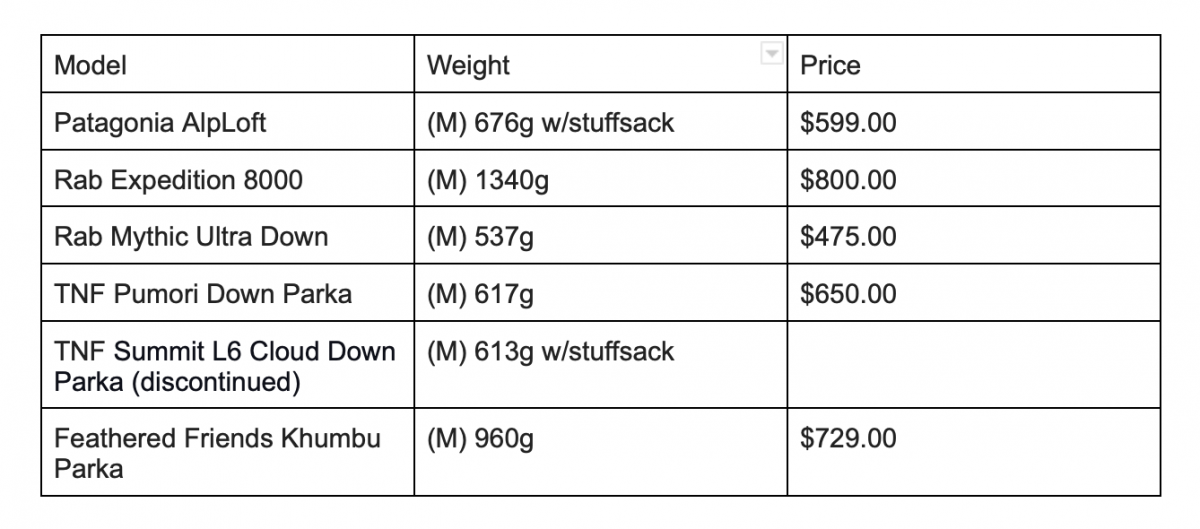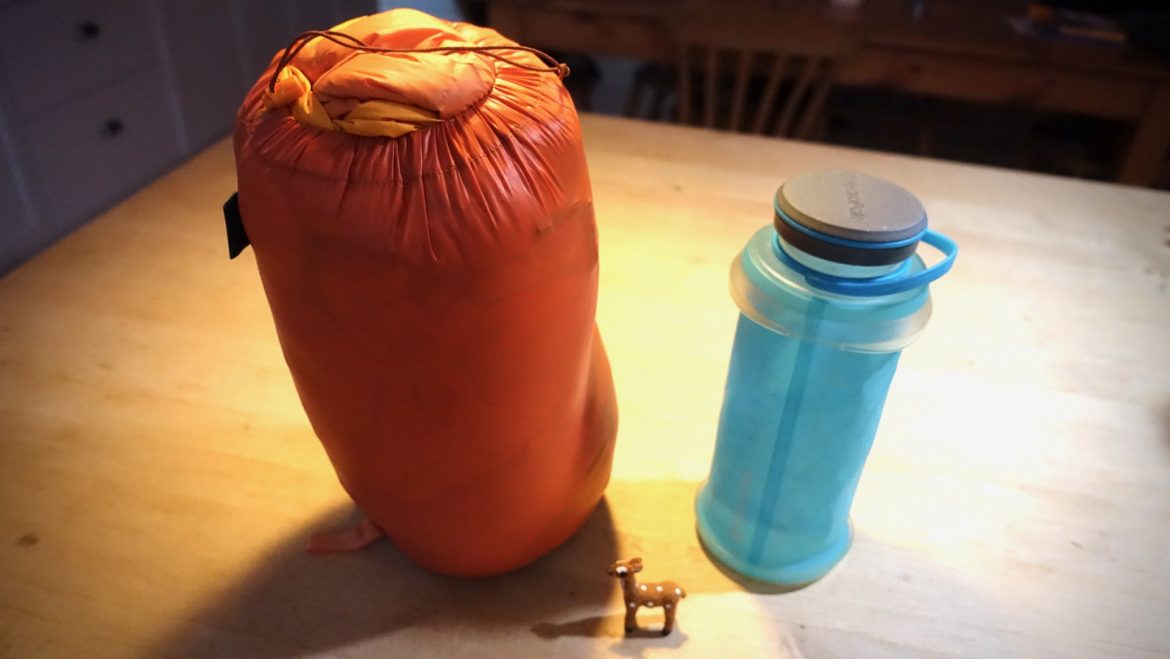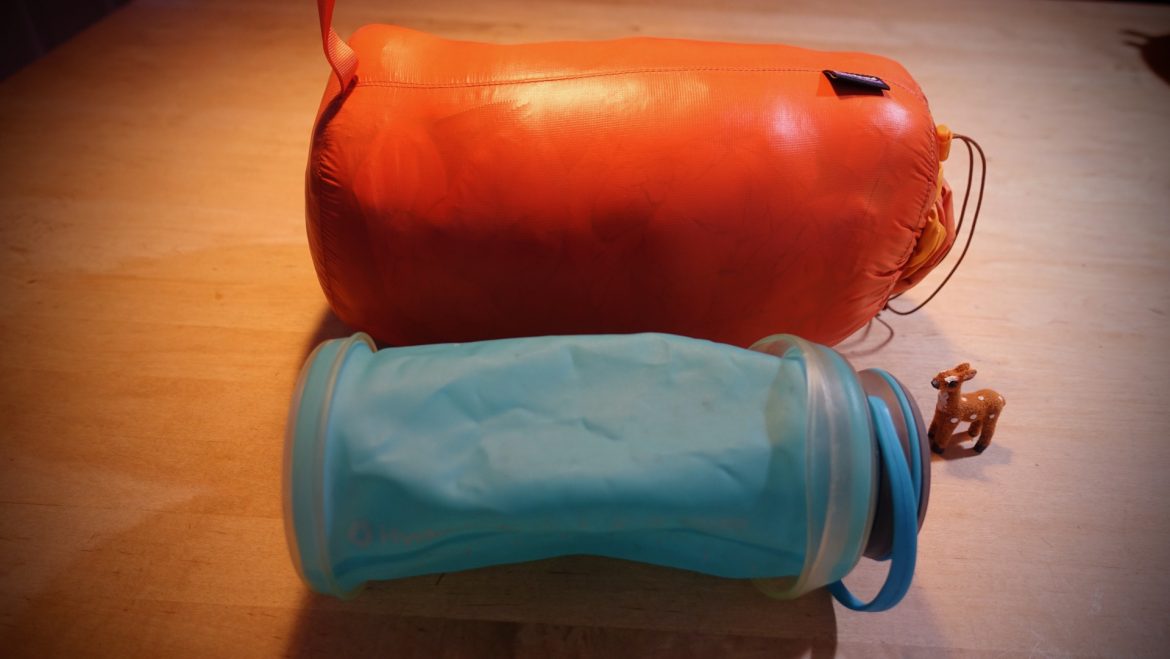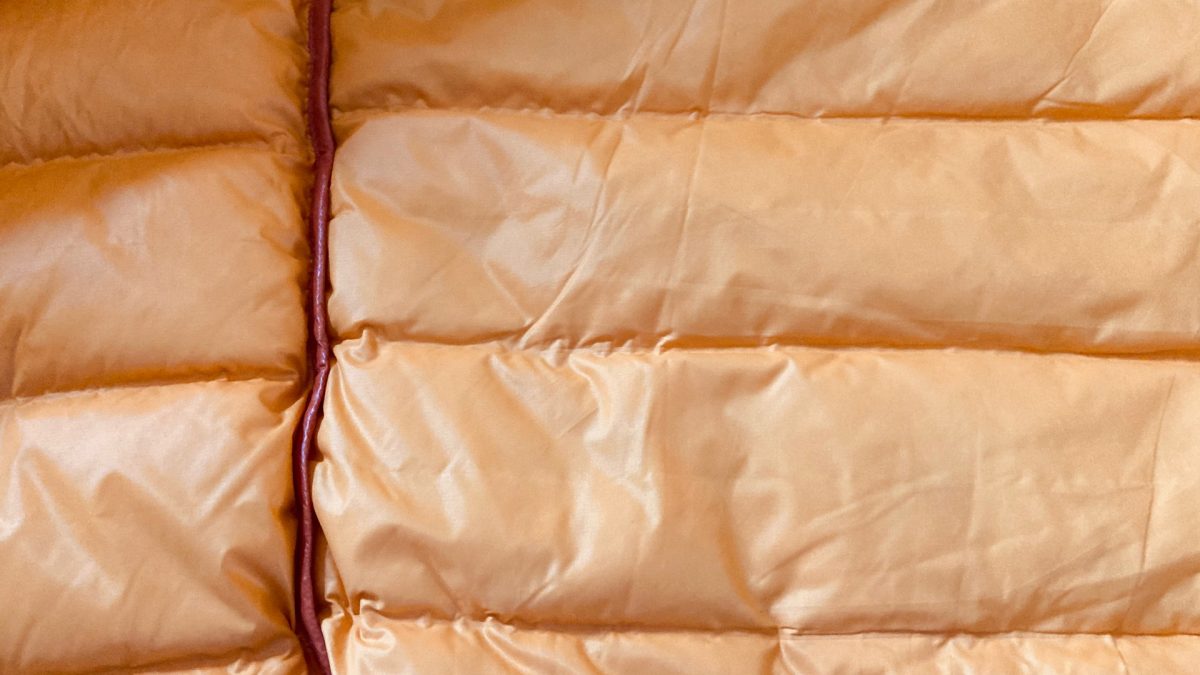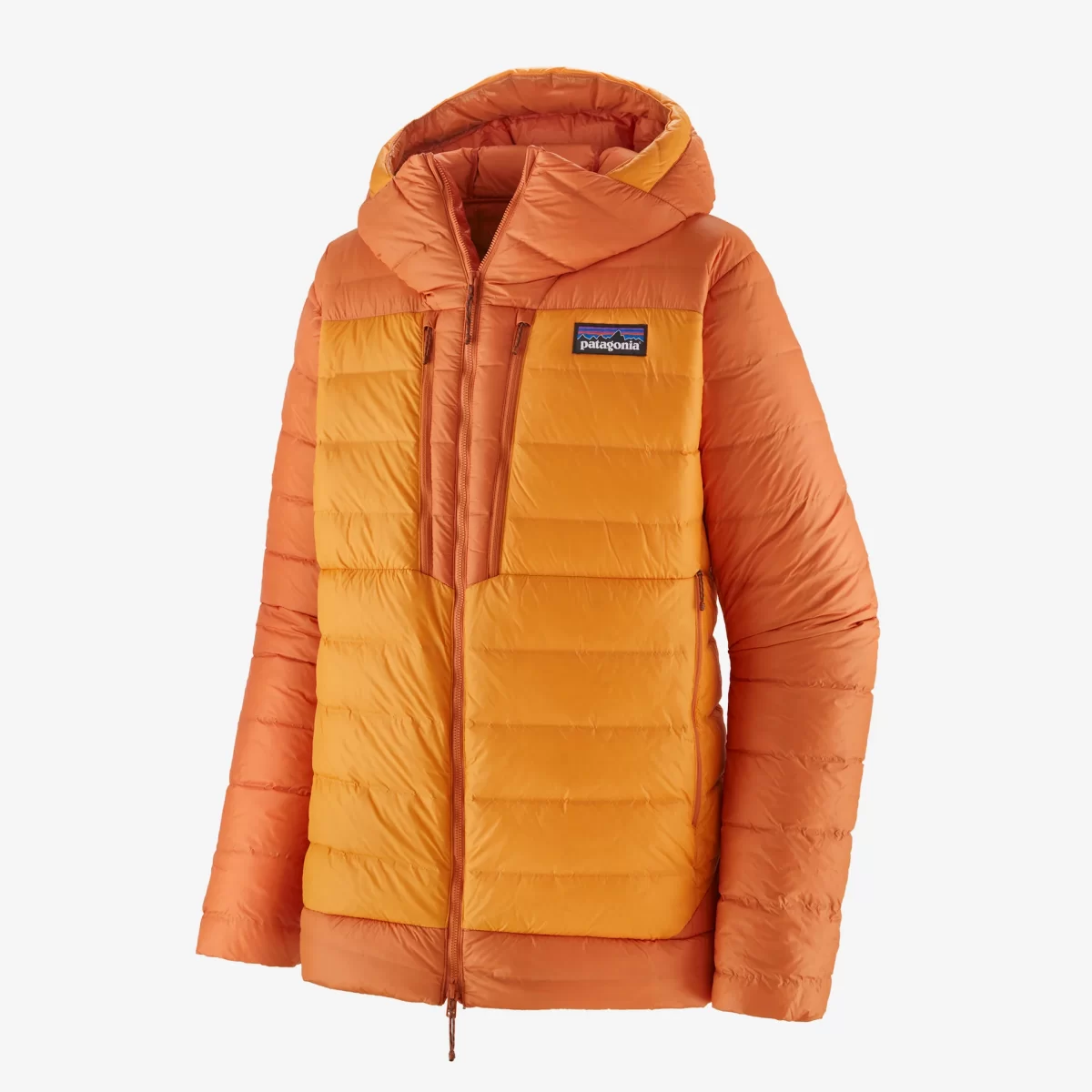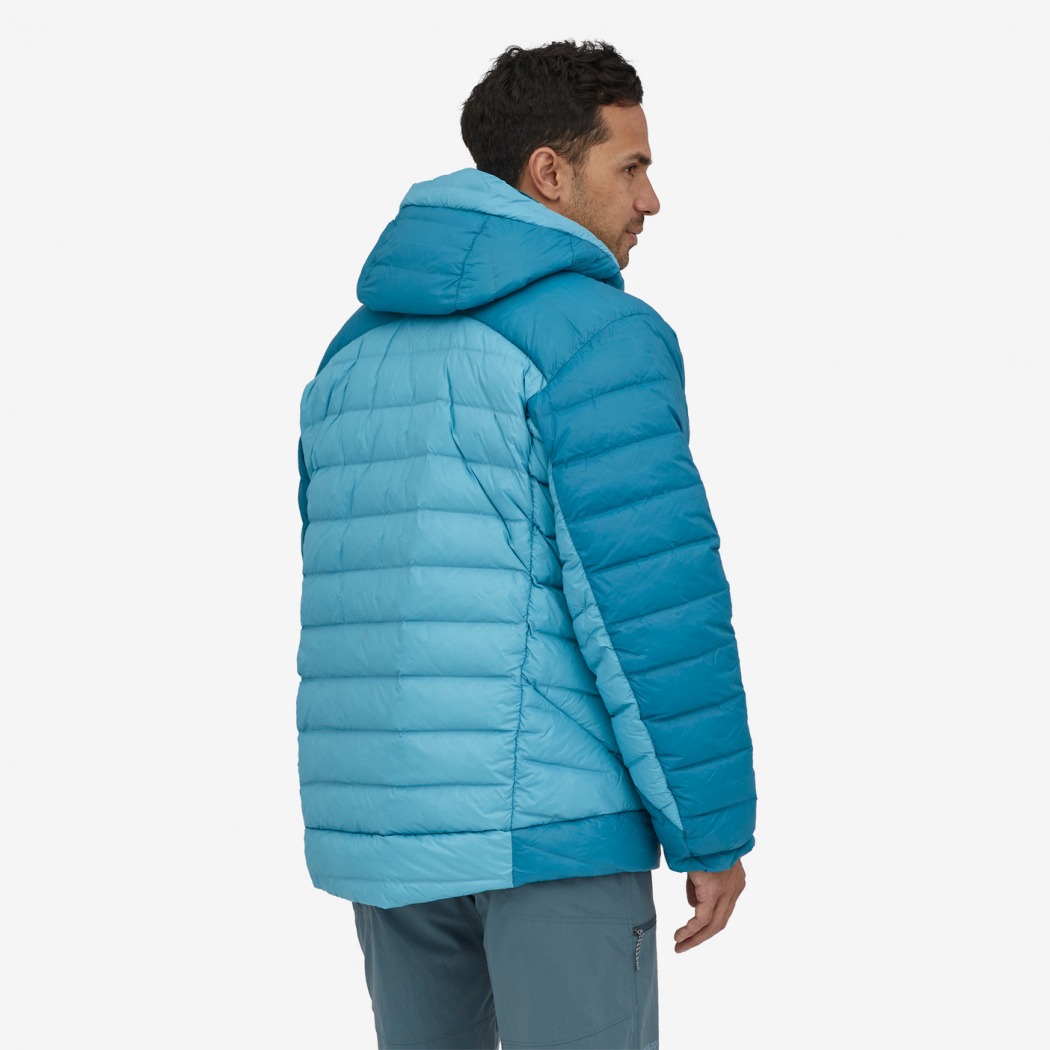In the new Patagonia AlpLoft Down Parka, we see a big puffy not overburdened with heft but, at the same time, not cursed with the weight-saving zeitgeist of the times. The jacket has a job to do: keep you warm and hold up. It does that. The build is near perfect in coupling durability, function, and a reasonable weight.
Note: Thanks to Aidan Whitelaw for giving the jacket a many-months beat-down and providing review feedback.
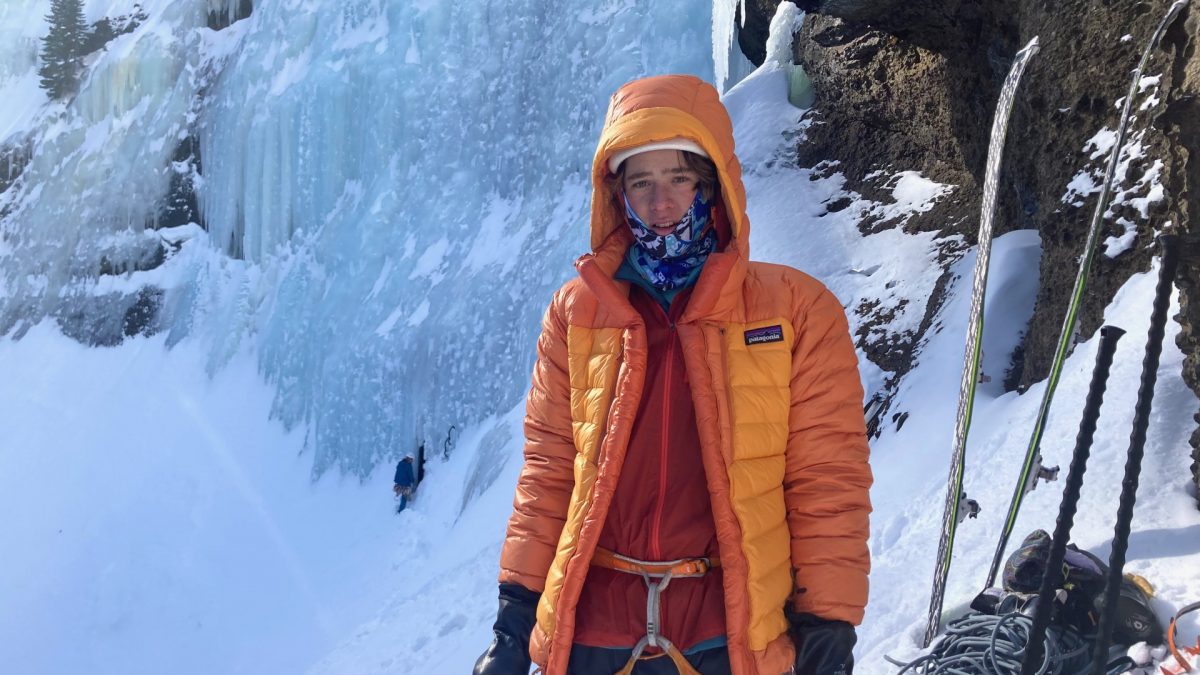
When your dad slows you down on the approach to the day’s climb/ski objective, finding a bit of sunshine in Hyalite Canyon and wearing an AlpLoft helps keep the soul warm and the family dynamics easy going. The AlpLoft features “kissing” draft tubes along the full length of the front zipper.
Pun intended: we are getting down, way down, with the new, soon-to-be-released Patagonia AlpLoft Down Parka. As puffies go, this is on the very puffy end of the spectrum; think of this as an on-route belay or digging-pits jacket that could, with the right layering system, tag along for a ski tour up the Big One in Alaska or suffice for an open-air bivy.
First, some justification; we got some pushback when we published a piece last season titled: Emergency Layers for Backcountry Travel. None of the folks I tour with stow a mega-puffy (synthetic or down) in their packs in the event it hits the fan. We mainly carry lighter weight down or synthetic puffies mid-winter for extra insulation. That’s not to say we believe we are being reckless, nor to say we feel we know what’s best for others. However, with that in mind, we looked at two mega down puffies that, under the right circumstances, a backcountry skier or rider might stuff in their pack.
(We will also review The North Face Summit L6 Cloud Down Parka — which has been replaced by what appears to be the same parka with a new name; the North Face Pumori Down Parka.)
AlpLoft Stats
Fill Weight: No fill weight specified — but lots of other variables to consider beyond fill weight.
Down: 800-fill-power RDS certified 100% virgin goose down (this jacket is not down-insufficient).
Front Zipper: Two-way and a reliable YKK zipper.
Pockets: Two large chest pockets (near center), two front hand pockets; all zippered, and two internal drop-in pockets.
Hood: Fitted for over helmet, single draw-cord to cinch down, baffled design for warmth.
Fabric: 3.7-oz 20-denier 3D Weave 100% recycled nylon with a ripstop face and a plain-weave main body liner; with a PFC-free DWR finish.
Weight: (M) 676g w/stuffsack.
Price: $599.00.
I’ll get any shade I might toss toward the Patagonia AlpLoft Down Parka out of the way first. As a big down parka, and one with a sufficiently durable face fabric, you have a few lighter options out there. But remember, seek a durable big puffy; you want these items to last years.
The Patagonia AlpLoft Down Parka packs down, but as many of these jackets do, it takes up space in the pack: it’s best if you have a 40L ski pack to ensure you’ve got the extra space for puffy stashing. And the jacket is warm — very warm — but is it possible to go warmer if you are heading to 8000m? It is. But the AlpLoft is the real deal, which Linden Mallory, head of Patagonia’s alpine line, calls a 6000m to 7000m jacket. I’m covered nearly twofold since Mt Hood, Oregon’s tallest peak, reaches 3,426 meters. And I mean, we have lots of Colorado readers; still covered, 14k equates to ~4267meters.
Otherwise, the AlpLoft Down Parka is a jacket that should last well beyond a decade (maybe two) of abuse. My last big puffy was a firstish gen Patagonia Fitz Roy that remains well-loved and has a new home with my neighbor. I purchased that piece in 2008, and it still rolls onward.
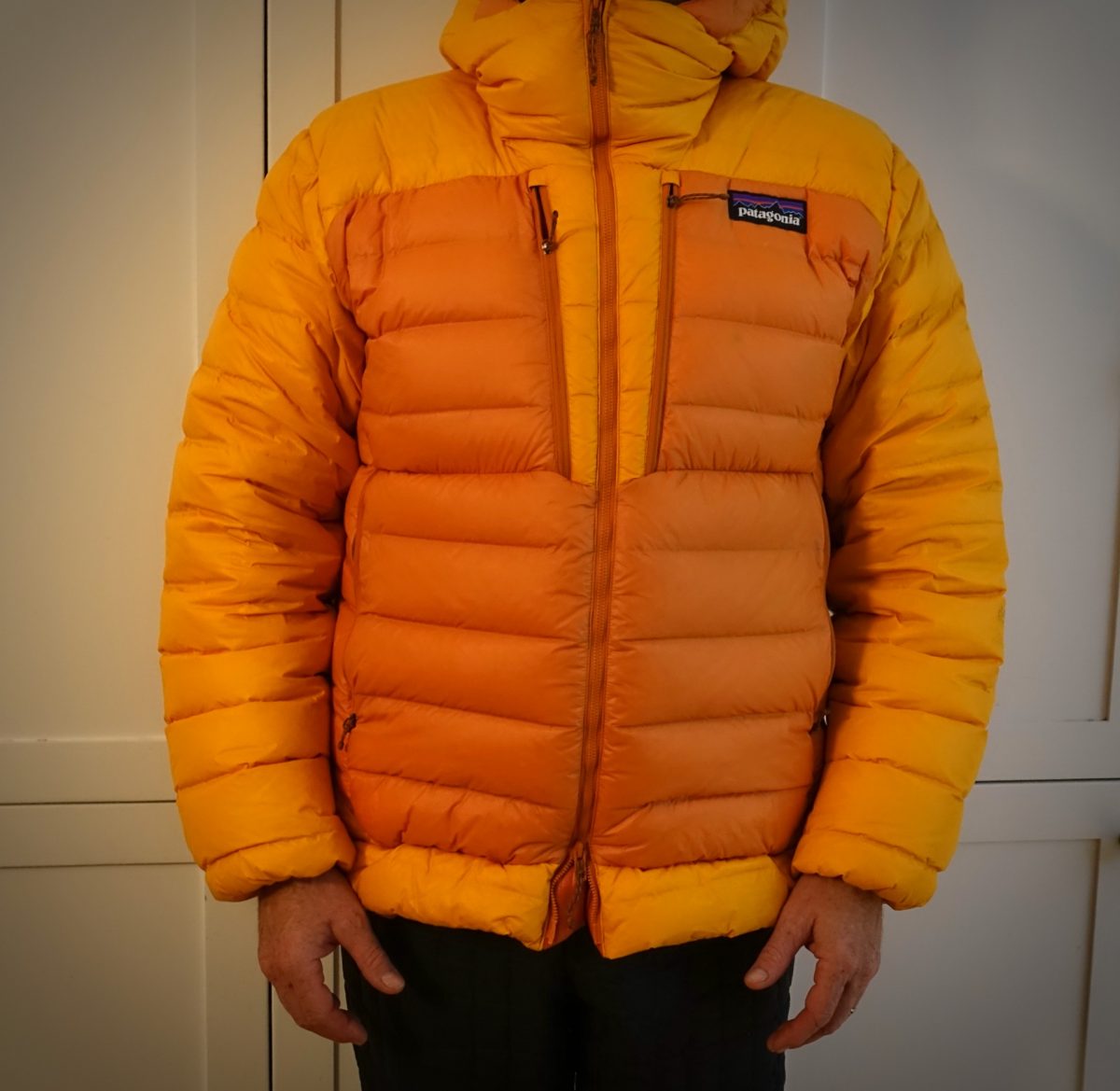
The AlpLoft features two zippered hand pockets, two zippered chest pocket and a 3D baffle design that enhances warmth and durability.
Here’s how the AlpLoft functions in a nutshell:
— As a basecamp jacket: high praise.
— As an on-route belay jacket: high praise. (I shared this piece with the older child who ice climbed plenty with the AlpLoft.)
— As a layer to warm the core during long transitions: high praise
— As a kick-back-and-enjoy-the-view-from-the-summit-puffy-but-it’s- &%$#*!! cold: all hail type praise.
The other aspect of the AlpLoft Down Parka that shines is the pockets. The two hand pockets are out of the way of most waistbelts.The two near-center chest pockets (borrowed from the venerable and we think discontinued Grade VII) are priceless for stashing a phone, lip balm, liner gloves, an extra hat, and even a compact camera. The chest pockets are voluminous.
The back has a slight drop hem to cover the bum, and the waist hem adjusts via cord locks in the hand pockets. Along the lines of keeping the elements out and the warmth in, a burly “kissing” draft tube runs the entire length of the front zip, and it works. (Most often, down jackets offer a draft tube on a single side — this feature just highlights Patagonia’s keen attention to detail in designing the AlpLoft Down Parka.)
Zip up all the way, and a generous draft collar protects the hairs on your chinny chin chin. Up top, a baffled and adjustable hood fits over a helmet, or otherwise, sans helmet, maintains a toasty noggin. Not to forget, the front zipper is two-way — a favorite of harness-wearing climbers/skiers and a feature I’ve come to love as a skier. It offers another means to dump heat without fully unzipping the jacket.
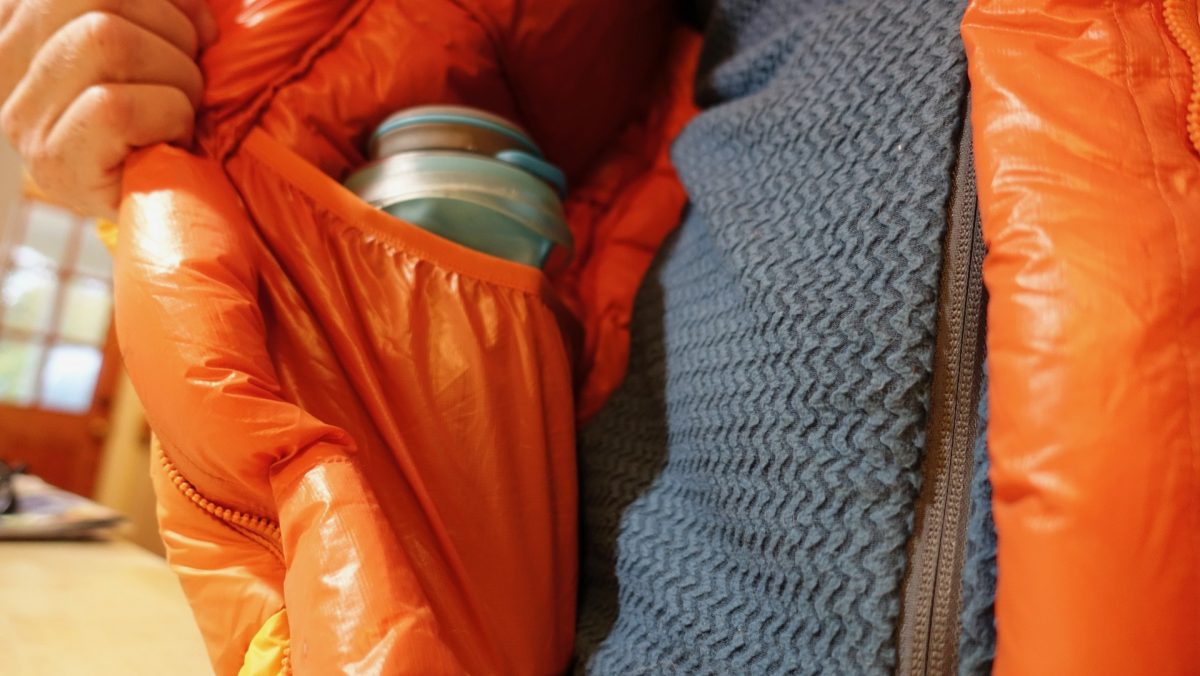
One of two internal drop-in pockets; the pockets are large enough to stash bulky gloves, or in this case, a liter water bottle.
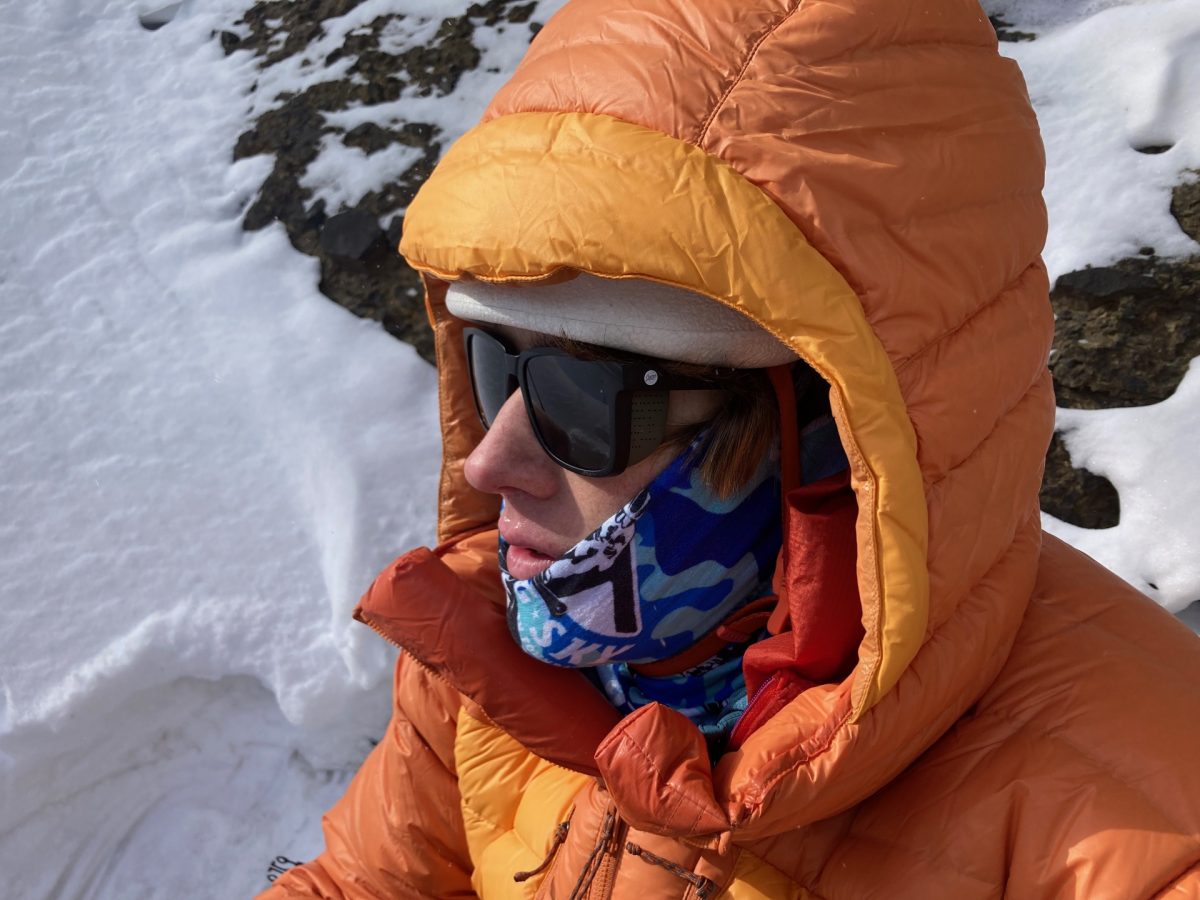
Designed as a full value down parka, the AlpLoft hood is baffled and fits nicely over a climbing/ski lid.
Internally, two drop pockets offer more internal storage. The drop pockets can secure a liter Nalgene for those AK climbers, and there’s ample room for gloves, hats, etc. The sleeves have elasticized cuffs and are easy on and easy off.
The Patagonia AlpLoft Down Parka can put up with a beating. The 3.7-oz 20-D outer fabric is perfect for the dual tasks of keeping the weight manageable and the durability high. I’ve made a mistake in the past of opting for an uber-lightweight outer fabric which amounted to adding plenty of duct tape and Tenacious Tape to seal rips on an all too frequent basis. The zippers are full-value YKK zips — zipping and unzipping do not require a dainty effort for fear of blowing out teeth or the box and pin at the zipper’s base. Solid zipper function is essential; the designers understand this and don’t feel obligated to cut corners. Further, the baffles are 2.5? wide. This dimension, according to Patagonia, optimizes warmth.
In the Patagonia AlpLoft Down Parka, we see a big puffy not overburdened with heft but, at the same time, not cursed with the weight-saving zeitgeist of the times. The jacket has a job to do: keep you warm and hold up. It does that. The build is near perfect in coupling durability, function, and a reasonable weight.
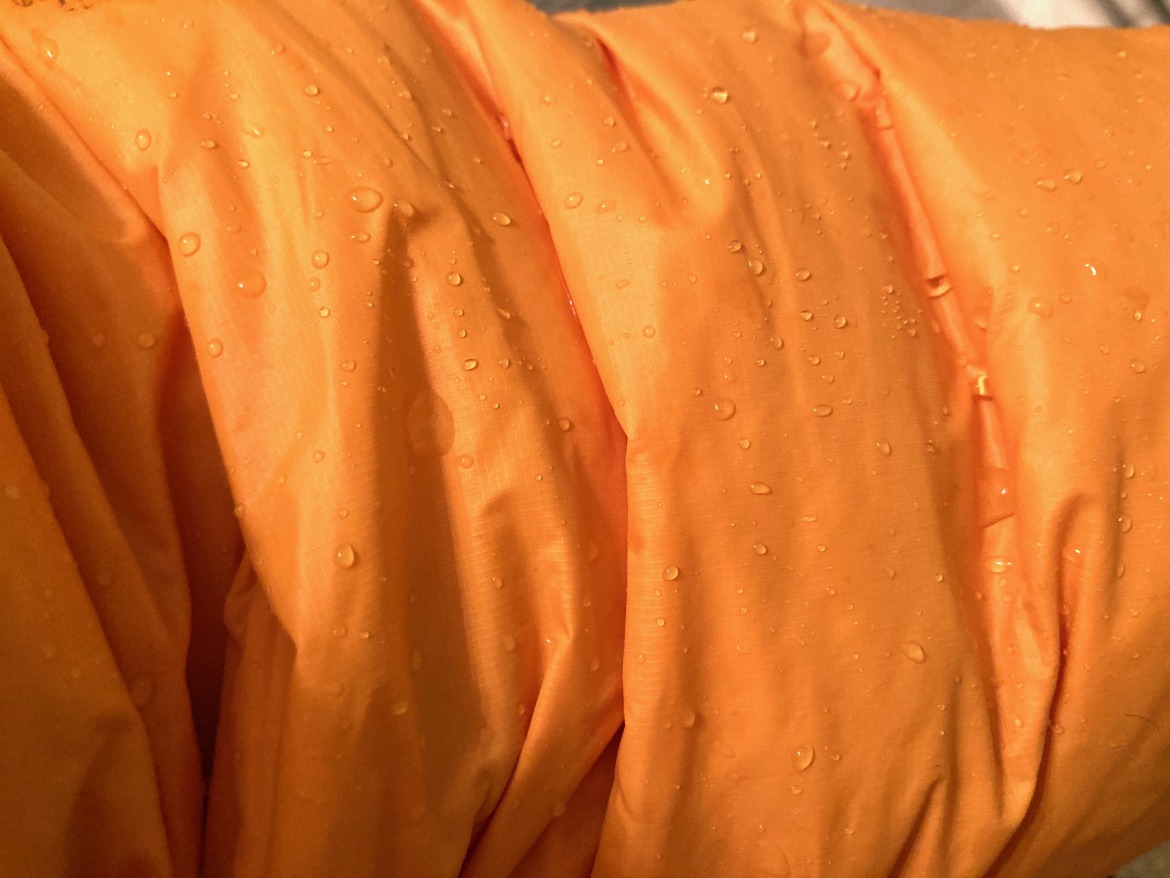
Although we recommend down for drier climates, the AlpLoft features a PFC DWR that held up great during an hour-long drizzle.
Waterproofness is as expected. A PFC-free DWR beads water. But we did not test the jacket in a downpour. It was, however, used recently as an overkill piece for drinking a few beverages during a steady drizzle. The outer fabric shed the drizzle, and the down remained dry. On multi-day trips in Montana, the jacket kept its loft and did not wet out. It’s possible to use this jacket as a layer to bulk up a light sleeping bag’s temp rating too. This is not the jacket to wear as active insulation on the skintrack unless you’re planning an early-season Mt. Vinson jaunt. Just in case you missed the memo, we recommend down outerwear for dryer climates. If you need a big puffy for wetter climates, check out synthetic-filled puffies.
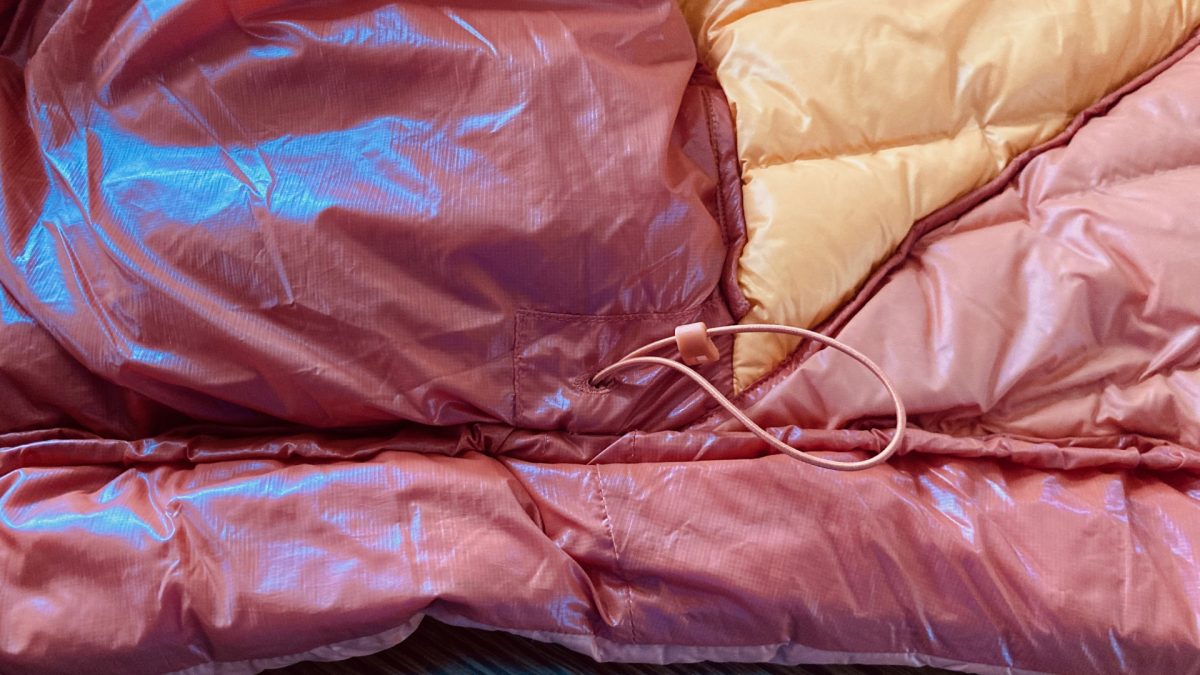
The AlpLoft’s hem is adjustable with an easy-access cinch cord. One nice touch here is the cord snugs above a generous hem baffle to better retain heat and keep out drafts.
The AlpLoft’s Build
There are many good and reliable down jackets out there. But what, besides the orange-creamsicle-themed color, sets this jacket apart?
For the most part, the jacket possesses few visible seams or stitching. More traditional down jackets rely on stitch-through construction to separate the down chambers (the face and liner fabric are literally stitched together), which is far simpler but leaves many cold spots. The stitching also leaves the face fabric more prone to loose threads, durability issues, and compromised weatherproofing. More modern baffled jackets use a “box wall” construction. Think of this as a series of small chambers holding the down in place without the face and liner fabric sewn together. The down has more space to loft (keeping you warmer).
Here’s Patagonia’s Mallory with an explainer: “The way that baffling construction is typically done is you have your face fabric, you have your liner fabric, and then you have a third piece of fabric, which is stitched to both the liner and the face to create that horizontal middle layer known as the box baffle. The stitching does a great job of holding that horizontal baffle in place. What it does, though, is it perforates the outer shell, so you get a slight loss of performance, slight but noticeable.”
Mallory says the stitch lines create holes, allow heat to escape, and affect weather protection. “When you’re ski touring, and it’s 35 degrees in pretty humid air, you start to rhyme up. Look down at your jacket — that rhyme collects on all of your quilt lines. So it’s another opportunity for moisture to get into the garment.”
Patagonia’s Grade VII down parka uses more elegant construction methods in the core of the garment to prevent perforating the face fabric.
“That jacket, the Grade VII, uses a pretty clever construction process where we sew that baffle to a piece of tape, like you might see on the inside of a hard shell, and then we tape that piece to the shell of the product. So we get the baffle, but there’s no puncture in the outer shell. This uses a little bit more work to build, but because there are no mechanical holes, there’s better weather protection again.”
Mallory says the Patagonia AlpLoft Down Parka borrows from what they learned from the Grade VII, with the AlpLoft’s construction even more elegant in its construction, which means better overall performance and longevity.

A close up shot of a well-loved 2008 Patagonia Fitz Roy baffle (these are boxed baffles): over time minute amounts of down work their way out between the stitched seams.

The AlpLoft’s no stitch baffles should prevent any down migration and minimize the dreaded cold spots.
I’ll try to wrap my brain around this 3-D puzzle. Patagonia constructs the AlpLoft’s baffles without seams or stitching between the liner (middle layer) and the inner baffle (the part of the baffle facing your chest). Mallory says the fabrics are woven together as a unit to create the baffle. The same method is used for the front-facing part of the baffle. OK, get ready for some more down-parka mental gymnastics.
“And so what we’ve done is create a material ‘package’ that is fully baffled. The jacket you’re holding in your hand is one piece of material: the face, and the liner in that baffle, are all linked. The best analogy that I have is cardboard. If you open up a cardboard box and look at the corrugated part, you have the two flat parts, and then there’s a ridgeline. That’s what the profile of the Patagonia AlpLoft Down Parka looks like if you were to cut it open and clear away the feathers. And it’s done by essentially weaving three pieces of material at the same time.”
And according to Mallory, at the product’s end of life, it’s easier to recycle, and the construction doesn’t require glues that in the past required costly and environmentally unsound refrigeration in hot, humid places like Vietnam, where Patagonia outsources some of its production.
Further, Mallory notes the construction method minimizes the traditional failure mechanisms — in other words, the jacket should last a long time.
In the hands of product testers, Mallory explained the jacket evolved not as a “here’s what this piece is for,” which can be prescriptive, but with the underlying ethos of asking testers how they were using the jacket and then optimizing for those uses.
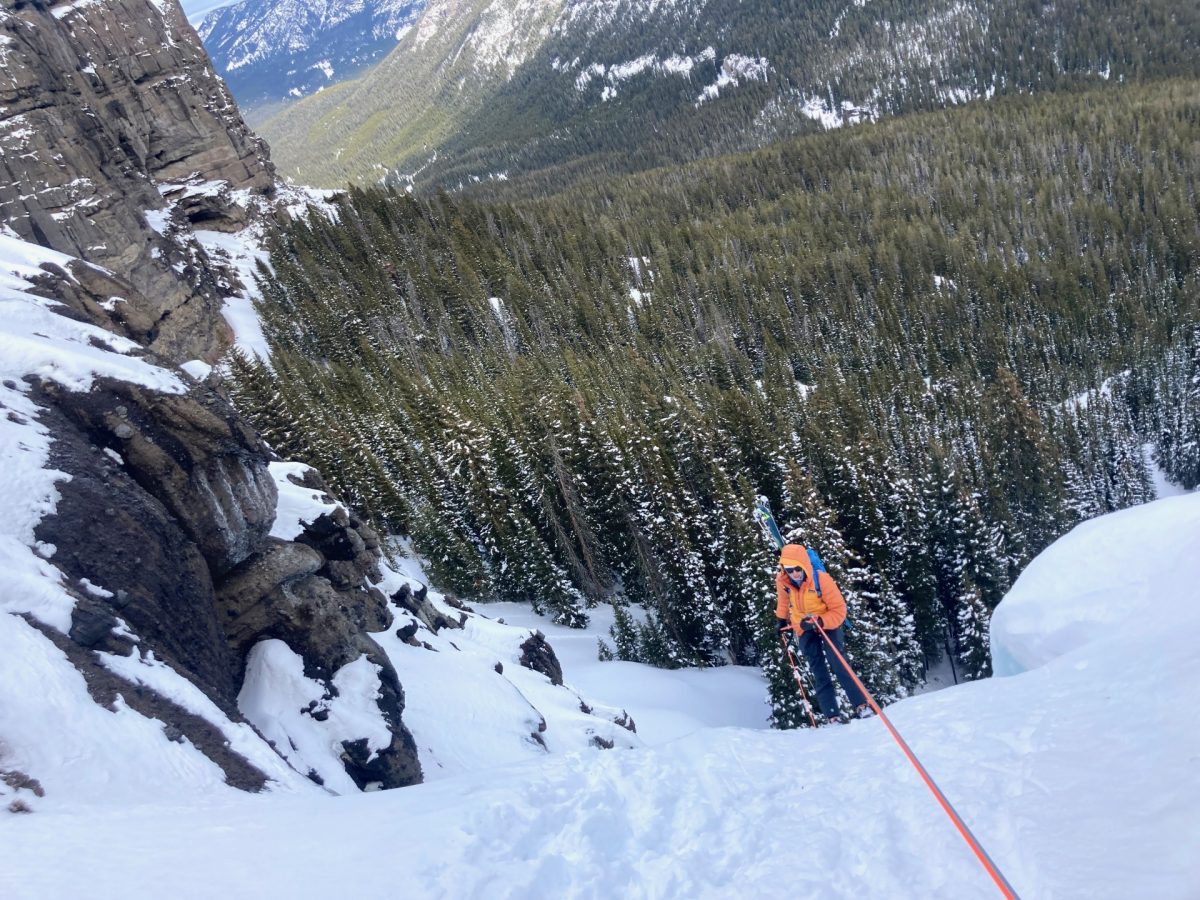
As a full value down parka, the AlpLoft can shake and bake as a belay puffy mid-winter and be a reliable outer layer in cold environments.
Lofty AlpLoft Final Thoughts
This jacket isn’t so bulky that you’d never bring it backcountry skiing. For those wanting a big down puffy for emergencies, this piece is a slam dunk. For those running cold and wanting to go big and warm and comfy — yup, no-brainer.
It’s wise to think of high-quality cold-weather down parkas as investments similar to a reliable down sleeping bag. Some expedition-style down sleeping bags, like a Feathered Friends unit, might run 750$ or more. I’ve still got my 30-year-old overstuffed expedition bag from Feathered Friends, and for the most part (the sleeping bag and dog had a minor wrestling match), the bag remains high functioning. I imagine Patagonia AlpLoft Down Parka like a high-quality sleeping bag: around for a long time and a staple of the cold weather kit. The initial upfront cost pays back over the long term with reliable warmth.
The AlpLoft is not Michelin-man bulky; the regular fit is slim enough to wear around and not feel like you’re burdened like Randy (Ralphie’s younger brother) in his snowsuit in A Christmas Story. Had Randy stormed Roger’s Pass on a cold-cold day or eyed a ski line deep in the Central Alaska Range, he could have used an AlpLoft. The AlpLoft Down Parka is a unisex piece; Patagonia recommends women size down one step to optimize fitting. The medium we sized fit great on 5’10” and 6’0” male skiers, while the large we tested and reviewed kept a 6’4” tester warm with the ability to layer over a Patagonia Houdini Jacket, a Patagonia R1 Hoody, and lightweight synthetic T.
Jason Albert comes to WildSnow from Bend, Oregon. After growing up on the East Coast, he migrated from Montana to Colorado and settled in Oregon. Simple pleasures are quiet and long days touring. His gray hair might stem from his first Grand Traverse in 2000 when rented leather boots and 210cm skis were not the speed weapons he had hoped for. Jason survived the transition from free-heel kool-aid drinker to faster and lighter (think AT), and safer, are better.

